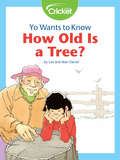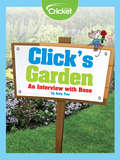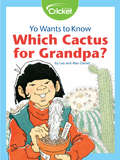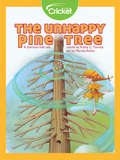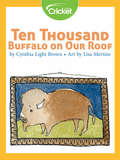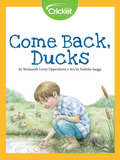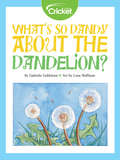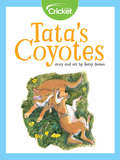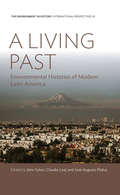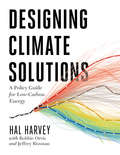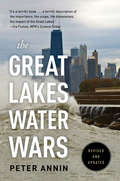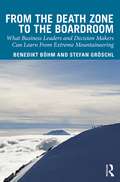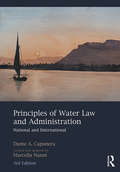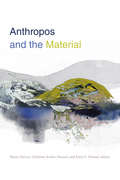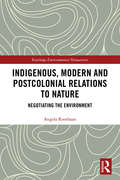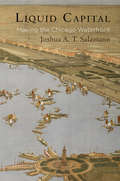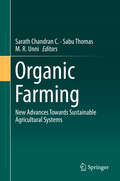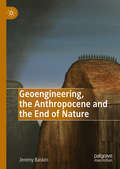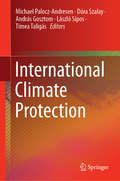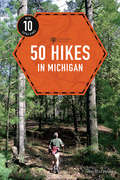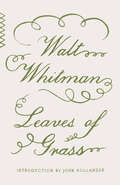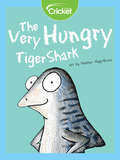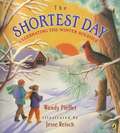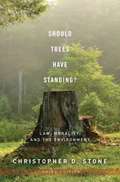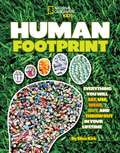- Table View
- List View
Yo Wants to Know: How Old Is a Tree?
by Lea DanielGrandpa surprises Yo with a tree to plant for his birthday, so the two can grow tall together.
Click's Garden: An Interview with Rose
by Amy TaoClick the mouse learns all about plants from his garden flower, Rose.
Yo Wants to Know: Which Cactus for Grandpa?
by Lea DanielGrandpa teaches Yo about how cactuses grow, thrive, and protect themselves.
The Unhappy Pine Tree: A German Folk Tale
by Kathy C. TierneyA pine tree is unhappy with its needles and wishes for different types of leaves instead. A fairy grants the tree its wishes, but the results are disappointing.
Ten Thousand Buffalo on Our Roof
by Cynthia Light BrownBaking in the summer heat can be unbearable, but sometimes the weather offers an exciting surprise!
Come Back, Ducks
by Shulamith Levey OppenheimA young boy watches the ducks in his family's pond and wonders why they've suddenly left one day.
What's So Dandy About the Dandelion?
by Gabriele GoldstoneThe name dandelion comes from the French for "tooth of the lion." But are these flowers actually dangerous?
Tata's Coyotes
by Betsy JamesAna and her father observe coyote pups in a nearby den while they wait for their apricot trees to fruit.
A Living Past: Environmental Histories of Modern Latin America (Environment in History: International Perspectives #13)
by John Soluri Claudia Leal José Augusto PáduaThough still a relatively young field, the study of Latin American environmental history is blossoming, as the contributions to this definitive volume demonstrate. Bringing together thirteen leading experts on the region, A Living Past synthesizes a wide range of scholarship to offer new perspectives on environmental change in Latin America and the Spanish Caribbean since the nineteenth century. Each chapter provides insightful, up-to-date syntheses of current scholarship on critical countries and ecosystems (including Brazil, Mexico, the Caribbean, the tropical Andes, and tropical forests) and such cross-cutting themes as agriculture, conservation, mining, ranching, science, and urbanization. Together, these studies provide valuable historical contexts for making sense of contemporary environmental challenges facing the region.
Designing Climate Solutions: A Policy Guide for Low-Carbon Energy
by Hal Harvey Robbie Orvis Jeffrey RissmanWith the effects of climate change already upon us, the need to cut global greenhouse gas emissions is nothing less than urgent. It's a daunting challenge, but the technologies and strategies to meet it exist today. A small set of energy policies, designed and implemented well, can put us on the path to a low carbon future. Energy systems are large and complex, so energy policy must be focused and cost-effective. One-size-fits-all approaches simply won't get the job done. Policymakers need a clear, comprehensive resource that outlines the energy policies that will have the biggest impact on our climate future, anddescribes how to design these policies well.Designing Climate Solutions:A Policy Guide for Low-Carbon Energy is the first such guide, bringing together the latest research and analysis around low carbon energy solutions. Written by Hal Harvey, CEO of the policy firm Energy Innovation, with Robbie Orvis and Jeffrey Rissman of Energy Innovation, Designing Climate Solutions is an accessible resource on lowering carbon emissions for policymakers, activists, philanthropists, and others in the climate and energy community. In Part I, the authors deliver a roadmap for understanding which countries, sectors, and sources produce the greatest amount of greenhouse gas emissions, and give readers the tools to select and design efficient policies for each of these sectors. In Part II, they break down each type of policy, from renewable portfolio standards to carbon pricing, offering key design principles and case studies where each policy has been implemented successfully.We don't need to wait for new technologies or strategies to create a low carbon future—and we can't afford to. Designing Climate Solutions gives professionals the tools they need to select, design, and implement the policies that can put us on the path to a livable climate future.
The Great Lakes Water Wars
by Peter AnninFor over a century the Great Lakes have been the target of controversial diversion schemes to sell, send, or ship water to thirsty communities, sometimes far from the source. In 2008, eight US states signed the historic Great Lakes Compact designed to protect the region's precious freshwater resources. Now water diversion controversies of a different kind are pitting communities and states against one another. Will the water wars ever be settled?With three new chapters and significant revisions that bring the story up to date over the past decade, this is the definitive behind-the-scenes account of the people and stories behind hard-fought battles to protect this precious resource that makes the region so special for the millions who call it home.
From the Death Zone to the Boardroom: What Business Leaders and Decision Makers Can Learn From Extreme Mountaineering
by Benedikt Boehm Stefan GroschlThis book explores experiences and reflections of an extreme sports athlete within the context of business, the latest scholarly works and research on topics that are relevant and timely for today’s managers and business leaders, and the daily challenges they face. Conviction, discipline, managing fear in high stakes situations, leading, working with teams and making decisions in extreme conditions - what will help you in extreme sports can also get you to your goals in business. In From the Death Zone to the Boardroom, speed ski mountaineer Benedikt Boehm tells gripping and inspirational stories about his fears, pain, suffering and facing death during his expeditions to some of the world's highest mountains. Throughout, his co-author and professor of leadership and management, Stefan Gröschl integrates scholarly ideas and works beyond traditional business boundaries providing you with unusual insights and thought-provoking alternatives for managing your business. The combination of extreme athlete, company leader, and business school scholar is unique, and ensures the relevance and timeliness of the selected themes, and the pellucidity of the conceptual context to a readership beyond academic boundaries. The result is advice that is both highly personal and empirically tested; a combination that makes for an absorbing read and unparalleled advice for you and your career.
Principles of Water Law and Administration: National and International, 3rd Edition
by Dante A. Caponera Marcella NanniThis book, which was first published in 1992 and then updated in 2007, provides a tool for dealing with the legal and institutional aspects of water resources management within national contexts and at the level of transboundary water resources. Like its two previous editions, it seeks to cover all aspects that need to be known in order to attain good water governance, but it provides updates concerning developments since 2007. These relate, inter alia, to the following: - the “greening” of water law, which calls for the progressive integration of environmental law principles into domestic and international water law; - the adoption, by the International Law Commission in 2008, of the Draft Articles on the Law of Transboundary Aquifers, and subsequent developments;- the emergence of the right to water as a self-standing human right;- the adoption of domestic water laws supporting integrated water resources management (IWRM) and enhanced public participation in planning and decision making;- the integration into these laws of tools facilitating adaptive water management as a response to climate variability and change;- progress in the implementation of EU law;- recent international agreements and judicial decisions;- efforts of regional organizations other than the EU to steer cooperation in the management of transboundary water resources and the harmonization of national laws;- institutional mechanisms for the management of transboundary water resources (surface and underground). Unique in its scope and nature, the book identifies the legal and institutional issues arising in connection with water resources management and provides guidelines for possible solutions in a manner accessible to a wide range of readers. Thus, it is a useful reference for lawyers and non-lawyers — engineers, hydrologists, hydrogeologists, economists, sociologists — dealing with water resources within government institutions, river basin commissions, international organizations, financing institutions and academic institutions, among other things, and also for students of disciplines related to water resources.
Anthropos and the Material
by Penny Harvey Christian Krohn-Hansen Knut G. NustadThe destructive effects of modern industrial societies have shaped the planet in such profound ways that many argue for the existence of a new geological epoch called the Anthropocene. This claim brings into relief a set of challenges that have deep implications for how relations between the human, the material, and the political affect contemporary social worlds. The contributors to Anthropos and the Material examine these challenges by questioning and complicating long-held understandings of the divide between humans and things. They present ethnographic case studies from across the globe, addressing myriad topics that range from labor, economics, and colonialism to technology, culture, the environment, agency, and diversity. In foregrounding the importance of connecting natural and social histories, the instability and intangibility of the material, and the ways in which the lively encounters between the human and the nonhuman challenge conceptions of liberal humanism, the contributors point to new understandings of the capacities of people and things to act, transform, and adapt to a changing world.
Indigenous, Modern and Postcolonial Relations to Nature: Negotiating the Environment (Routledge Environmental Humanities)
by Angela RoothaanIndigenous, Modern and Postcolonial Relations to Nature contributes to the young field of intercultural philosophy by introducing the perspective of critical and postcolonial thinkers who have focused on systematic racism, power relations and the intersection of cultural identity and political struggle. Angela Roothaan discusses how initiatives to tackle environmental problems cross-nationally are often challenged by economic growth processes in postcolonial nations and further complicated by fights for land rights and self-determination of indigenous peoples. For these peoples, survival requires countering the scramble for resources and clashing with environmental organizations that aim to bring their lands under their own control. The author explores the epistemological and ontological clashes behind these problems. This volume brings more awareness of what structurally obstructs open exchange in philosophy world-wide, and shows that with respect to nature, we should first negotiate what the environment is to us humans, beyond cultural differences. It demonstrates how a globalizing philosophical discourse can fully include epistemological claims of spirit ontologies, while critically investigating the exclusive claim to knowledge of modern science and philosophy. This book will be of great interest to students and scholars of environmental philosophy, cultural anthropology, intercultural philosophy and postcolonial and critical theory.
Liquid Capital: Making the Chicago Waterfront (American Business, Politics, and Society)
by Joshua A. SalzmannIn the nineteenth century, politicians transformed a disease-infested bog on the southwestern shore of Lake Michigan into an intensively managed waterscape supporting the life and economy of Chicago, now America's third-most populous city. In Liquid Capital, Joshua A. T. Salzmann shows how, through a combination of entrepreneurship, civic spirit, and bareknuckle politics, the Chicago waterfront became a hub of economic and cultural activity while also the site of many of the nation's precendent-setting decisions about public land use and environmental protection. Through the political saga of waterfront development, Salzmann illuminates Chicago's seemingly paradoxical position as both a paragon of buccaneering capitalism and assertive state power.The list of actions undertaken by local politicians and boosters to facilitate the waterfront's success is long: officials reversed a river, built a canal to fuse the Great Lakes and Mississippi River watersheds, decorated the lakeshore with parks and monuments, and enacted regulations governing the use of air, land, and water. With these feats of engineering and statecraft, they created a waterscape conducive to commodity exchange, leisure tourism, and class harmony—in sum, an invaluable resource for profit making. Their actions made the city's growth and the development of its western hinterlands possible. Liquid Capital sheds light on these precedent-making policies, their effect on Chicago's development as a major economic and cultural force, and the ways in which they continue to shape legislation regarding the use of air and water.
Organic Farming: New Advances Towards Sustainable Agricultural Systems
by C. Sarath Chandran Sabu Thomas M. R. UnniThis volume provides an overview of the fundamental concepts and recent advancements in organic farming, a form of agriculture that is increasing rapidly in popularity. Readers will discover information on the history of organic farming, environmental friendly practices and challenges, and innovations in the field.The chapter authors analyze pertinent aspects of this integrated farming system including strategies to improve seed quality, methods to improve soil fertility, and the advantages of using organic fertilizers. Particular attention is also given to weed management practices, bioenergy production and insights into the ways organic farming can adapt to global climate change and build sustainable food systems for future generations. Scientists, decision-makers, professors, and farmers who wish to work towards making agricultural systems more sustainable will find this book appealing.
Geoengineering, the Anthropocene and the End of Nature
by Jeremy BaskinThis book takes a critical look at solar geoengineering as an acceptable means for addressing climate change. Baskin explores the assumptions and imaginaries which animate ‘engineering the climate’ and discusses why this climate solution is so controversial. The book explains geoengineering’s past, its revival in the mid-2000s, and its future prospects including its shadow presence in the Paris climate accord. The main focus however is on dissecting solar geoengineering today – its rationales, underpinning knowledge, relationship to power, and the stance towards nature which accompanies it. Baskin explores three competing imaginaries associated with geoengineering: an Imperial imaginary, an oppositional Un-Natural imaginary, and a conspiratorial Chemtrail imaginary. He seeks to explain why solar geoengineering has struggled to gain approval and why resistance to it persists, despite the support of several powerful actors. He provocatively suggests that reconceptualising our present as the Anthropocene might unwittingly facilitate the normalisation of geoengineering by providing a sustaining socio-technical imaginary. This book is essential reading for those interested in climate policy, political ecology, and science & technology studies.
International Climate Protection
by Michael Palocz-Andresen Dóra Szalay András Gosztom László Sípos Tímea TaligásThis book explains the current climate protection processes and technologies, and informs the readers of the limiting factors and opportunities for future development. It represents the highest level of knowledge from leading scientists all over the world. Original high quality figures maximize understanding of the text. The book also introduces a new concept (climatographic), which provides a well pronounced solution to climate protection that is easily understandable for all levels of readers.
50 Hikes in Michigan: Sixty Walks, Day Trips, And Backpacks In The Lower Peninsula (Explorer's 50 Hikes #0)
by Jim DuFresneExplore the hills, ridges, sand dunes, and breathtaking views of the Great Lake State, one trail at a time Michigan’s Lower Peninsula offers extremely diverse terrain, from beaches that are home to shipwrecks and lighthouses, streams populated with trout, and wildflower and orchid fields to spaces with unusual geological formations, sand dunes, and steep climbs, and beech forests perfect for birding. Each chapter begins with an overview of each hike—the type of hike, total distance, time, difficulty, highlights, maps, and trailhead GPS coordinates. Readers will learn the best way to access the trail, tips and suggestions, and key features to look out for along the way (scenic views, drinking water, rest stops, waterfalls, and old growth trees). Whether readers are setting out in the Sleeping Bear region to observe shipwrecks, open dunes, and beach walking on the South Manitou Island trail, 50 Hikes in Michigan (with 10 bonus hikes!) is the perfect companion.
Leaves of Grass: Including A Fac-simile Autobiography, Variorum Readings Of The Poems And A Department Of Gathered Leaves... - Primary Source Edition (Vintage Classics #Vol. No. 9)
by Walt WhitmanAbraham Lincoln read it with approval, but Emily Dickinson described its bold language and themes as "disgraceful." Ralph Waldo Emerson found it "the most extraordinary piece of wit and wisdom that America has yet produced." Published at the author's expense on July 4, 1855, Leaves of Grass inaugurated a new voice and style into American letters and gave expression to an optimistic, bombastic vision that took the nation as its subject. Unlike many other editions of Leaves of Grass, which reproduce various short, early versions, this Modern Library Paperback Classics "Death-bed" edition presents everything Whitman wrote in its final form, and includes newly commissioned notes.
The Very Hungry Tiger Shark
by Liz HuyckTiger sharks eat almost anything they can catch. But the practice of dumping garbage in oceans is harmful to these predators who tend to eat something without realizing it isn’t food. This causes tiger sharks to eat license plates and other non-food items they cannot digest.
The Shortest Day: Celebrating The Winter Solstice
by Wendy Pfeffer Jesse ReischThe beginning of winter is marked by the solstice, the shortest day of the year. Long ago, people grew afraid when each day had fewer hours of sunshine than the day before. Over time, they realized that one day each year the sun started moving toward them again. In lyrical prose and cozy illustrations, this book explains what the winter solstice is and how it has been observed by various cultures throughout history. Many contemporary holiday traditions were borrowed from ancient solstice celebrations. <P><P> <P><P> Simple science activities, ideas for celebrating the day in school and at home, and a further-reading list are included.
Should trees have Standing: Law, Morality, and the Environment,
by Christopher D. StoneIn this collection of essays, the author argues that natural objects, such as trees, should have legal rights through the appointment of guardians designated to protect them. It covers such areas as: agriculture and the environment: can the oceans be harbored; establishing a guardian for future generations; reflections on sustainable development; how to heal the planet; environmentalism, is it dead.
Human Footprint: Everything you will eat, use, wear, buy, and throw out in your Lifetime (National Geographic Kids)
by Ellen KirkMakes you want to step more lightly on the planet! Perfectly timed for Earth Day, this book doesn't preach or judge, but simply shows kids—in an exciting, visual way—how humans interact with the environment and how we can lessen our impact.
